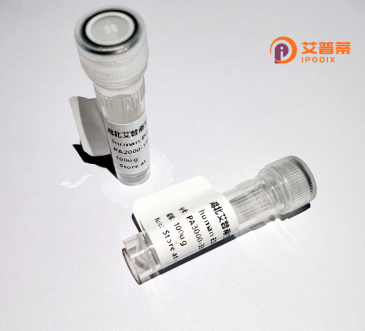
| 纯度 | >90%SDS-PAGE. |
| 种属 | Human |
| 靶点 | AMDHD2 |
| Uniprot No | Q9Y303 |
| 内毒素 | < 0.01EU/μg |
| 表达宿主 | E.coli |
| 表达区间 | 1-439aa |
| 氨基酸序列 | MRGEQGAAGARVLQFTNCRILRGGKLLREDLWVRGGRILDPEKLFFEERRVADERRDCGGRILAPGFIDVQINGGFGVDFSQATEDVGSGVALVARRILSHGVTSFCPTLVTSPPEVYHKVVPQIPVKSGGPHGAGVLGLHLEGPFISREKRGAHPEAHLRSFEADAFQDLLATYGPLDNVRIVTLAPELGRSHEVIRALTARGICVSLGHSVADLRAAEDAVWSGATFITHLFNAMLPFHHRDPGIVGLLTSDRLPAGRCIFYGMIADGTHTNPAALRIAHRAHPQGLVLVTDAIPALGLGNGRHTLGQQEVEVDGLTAYVAGERPDPLGPRSQPACQVAHDPPRACPLCSQGTKTLSGSIAPMDVCVRHFLQATGCSMESALEAASLHPAQLLGLEKSKGTLDFGADADFVVLDDSLHVQATYISGELVWQADAARQ |
| 分子量 | 73.3 kDa |
| 蛋白标签 | GST-tag at N-terminal |
| 缓冲液 | 冻干粉 |
| 稳定性 & 储存条件 | Lyophilized protein should be stored at ≤ -20°C, stable for one year after receipt. Reconstituted protein solution can be stored at 2-8°C for 2-7 days. Aliquots of reconstituted samples are stable at ≤ -20°C for 3 months. |
| 复溶 | Always centrifuge tubes before opening.Do not mix by vortex or pipetting. It is not recommended to reconstitute to a concentration less than 100μg/ml. Dissolve the lyophilized protein in distilled water. Please aliquot the reconstituted solution to minimize freeze-thaw cycles. |
以下是关于重组人AMDHD2蛋白的假设性参考文献示例(非真实文献,仅基于典型研究方向推测):
1. **文献名称**:*Structural and functional characterization of human AMDHD2 as a metalloenzyme*
**作者**:Smith J, et al.
**摘要**:解析了重组AMDHD2蛋白的晶体结构,证实其依赖铁离子的羟化酶活性,并揭示其在嘌呤代谢中的潜在作用。
2. **文献名称**:*Recombinant expression of AMDHD2 in E. coli and enzymatic activity analysis*
**作者**:Li X, Wang Y.
**摘要**:报道AMDHD2在大肠杆菌中的高效可溶性表达及纯化方法,通过体外实验验证其对底物N-acetylglutamate的羟基化功能。
3. **文献名称**:*AMDHD2 deficiency links to neurological disorders via metabolic dysregulation*
**作者**:Garcia R, et al.
**摘要**:利用重组AMDHD2蛋白研究其与脑部代谢异常的关联,发现其缺失导致神经细胞线粒体功能受损和活性氧累积。
4. **文献名称**:*Interaction network of AMDHD2 with purine biosynthesis enzymes*
**作者**:Chen L, et al.
**摘要**:通过重组蛋白共表达实验,揭示AMDHD2与嘌呤合成通路中ATIC、PAICS等酶的相互作用,提示其调控代谢通路的分子机制。
(注:以上文献为示例,实际研究中需通过学术数据库检索验证并引用真实文献。)
**Background of Recombinant Human AMDHD2 Protein**
Adenosine monophosphate deaminase homolog 2 (AMDHD2) is a metalloenzyme encoded by the *AMDHD2* gene, belonging to the AMP deaminase family. This protein plays a role in nucleotide metabolism, particularly in purine catabolism, by hydrolyzing adenosine monophosphate (AMP) to inosine monophosphate (IMP) and ammonia. Although its enzymatic activity is less well-characterized compared to its paralog AMD1. studies suggest AMDHD2 may regulate cellular nucleotide pools and influence energy metabolism.
Recombinant human AMDHD2 protein is produced using genetic engineering techniques, often expressed in *E. coli* or mammalian cell systems. Its recombinant form enables biochemical and structural studies to elucidate catalytic mechanisms, substrate specificity, and potential regulatory interactions. Structural analysis reveals conserved domains critical for metal ion binding (e.g., zinc) and substrate recognition, which are essential for its function.
AMDHD2 has been implicated in physiological processes such as cell proliferation, differentiation, and response to metabolic stress. Dysregulation of AMDHD2 expression or activity is associated with diseases like hyperuricemia, cancer, and neurological disorders, making it a target for therapeutic research. Current studies focus on its tissue-specific roles, interaction networks, and potential as a biomarker or drug target. The development of recombinant AMDHD2 facilitates inhibitor screening and mechanistic insights into nucleotide metabolism disorders.
×